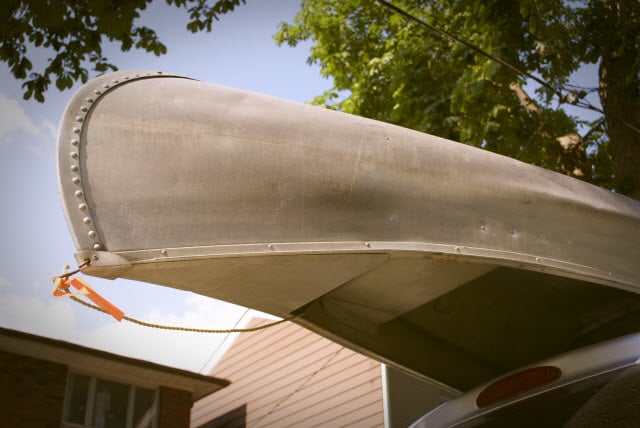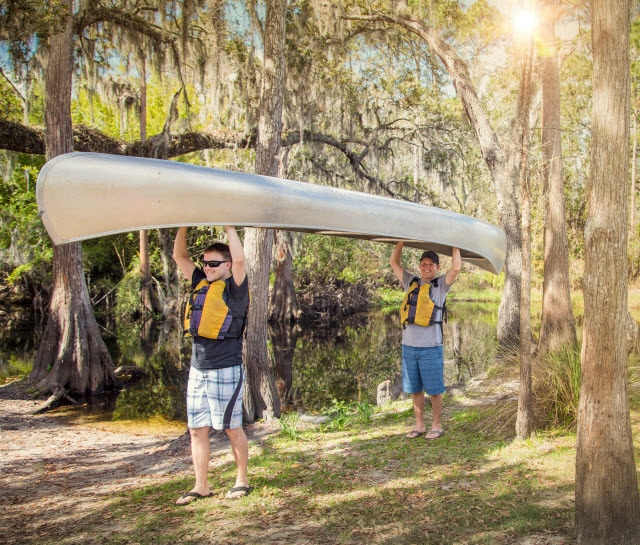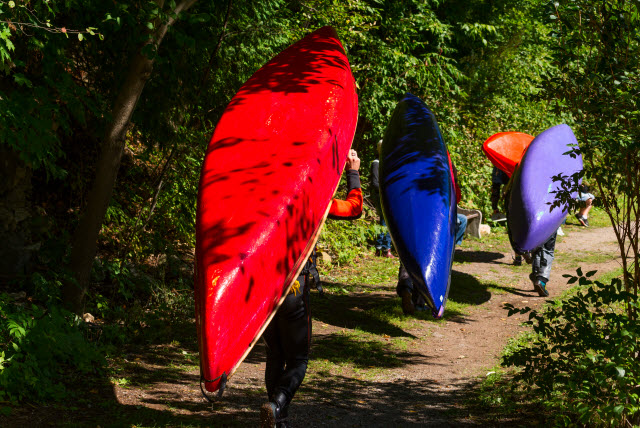Taking your canoe out on the water is an incredibly fun. Getting your canoe to the water? Not so much. Before you just toss your canoe on top of your car, truck or SUV, it is essential to know how to transport a canoe properly (and safely). I’ll go over some tips that will keep your canoe safe on the trip to and from the water today.
Knowing how to handle a boat on the water is one thing, but the canoe’s basic design presents a unique challenge in transporting it.
You don’t want to risk having your canoe fall off of your vehicle on route. This can damage your canoe but, more importantly, it poses a big risk to you and other drivers.
Similarly, getting your canoe onto or off of your vehicle has its own challenges.
Canoes aren’t always designed to be carried. And if you’re canoeing solo you’ll need to know the right technique to get your canoe up onto your shoulders.
How to Secure Your Canoe to Your Vehicle
Securing your canoe to your car is the essential first step to knowing how to transport your canoe.
Your type of vehicle is the biggest factor in figuring out how you strap your canoe into place, but the type of canoe (what it’s made of) you have matters too. Some canoes can be strapped down hard, others can be deformed with too much pressure on a hot day.
If you drive a sedan, then you’ll need to use a different method than you will if you have a truck or SUV.
Whether your vehicle comes with a roof-mounted rack also makes a difference.
Why You’ll Transport a Canoe Upside Down on Your Car
When securing your canoe to your vehicle, you’ll strap your canoe into place so the gunwales (the upper edges of the canoe) face down.

There are three advantages to this:
- The hull faces up and prevents water from pooling in the canoe if it rains while you’re in transit.
- A Canoe’s gunwales are the most structurally sound part of the canoe and the widest part of the canoe. Having the widest part at the bottom will provide extra stability.
- There will be less wind resistance while you drive.
If you’re taking multiple canoes, then you’ll need to strap each onto your vehicle individually for maximum safety.
You want to strap down both the stern and bow. If a rack or strap were to fail, then you risk your canoe falling off of your car. Having dual security from strapping both the bow and stern prevents that from occurring.
The Best Methods for Transporting a Canoe on Your Vehicle
I’ll share each of the most popular methods for securing your canoe to your car, truck, SUV or trailer here. I’ll also provide some tips to make sure your canoe won’t fall off below.
Let’s start with
Using Foam Blocks to Transport a Canoe on Your Car
To transport a canoe on a sedan, you likely won’t have a roof rack. But it’s still possible to do so safely.
You’ll need to use foam blocks to secure your canoe into place. This is the most economical system, and it works well. This kit on Amazon with foam blocks, straps, and tie-downs is less than $50.
You should know that this method is not as secure as a traditional roof rack. You’ll need to make sure you tie your canoe down properly and take it slow while on the road.
The way foam transport blocks work is they will fit over the gunwales of the canoe. They cushion the canoe as it sits on the roof of your vehicle, and prevent damage to your car.
When you strap the canoe down over the top of the hull (do it right above the foam blocks and run the strap inside the car with the doors open), cinch down hard with the straps to compress the blocks on your roof.

Finally, tie the canoe down at the bow and stern, using rope to secure the front and rear of your vehicle to the car frame below the bumper. Make sure you tie to something structural that doesn’t move.
It’s important to tie the canoe at the bow and stern in addition to using straps over the foam blocks. If you don’t tie the bow and stern, stopping quickly could cause the canoe to shift forward right over the front of your vehicle.
How to Transport a Canoe on a Roof Rack
A roof-mounted rack is more secure, and it’s preferable to using foam blocks.
The horizontal bars provide an additional system for securing your canoe to your vehicle. You can mount the canoe directly to the rack, though additional padding is never a bad idea. You can purchase padding designed specifically for this purpose, like J-cradles or stackers. If you’re on a budget, duct-taping pool noodles or a yoga mat to the bars would work as well. These can offer additional ways to securely hold the canoe to your vehicle.
For cars without a roof rack, an upgrade over foam blocks is something like the HandiRack inflatable roof rack bars. These work well and can work on both small and large vehicles.
A saddle offers an easier way to load a small canoe or kayak onto your vehicle. If you are transporting it by yourself, then a saddle is especially helpful if you have a very small canoe. Some have rollers or slippery fabric to remove the necessity of lifting your canoe to your vehicle’s roof. Automated varieties are available for more money. For example, Thule’s Hullavator has a mechanical system that lowers the saddle to waist level in order to easily strap the canoe into place prior to raising it.
Other Methods You Can Use to Transport a Canoe
Depending on what you have available, you can also transport your canoes using a trailer. Trailers are increasingly popular since they offer more safety, however they’re not cheap. If you’re taking your canoe out enough, then it can be a worthwhile investment to make. Trailers for transporting canoes or kayaks come in many varieties, but they all allow you to load your canoe at waist height instead of having to lift it over your head.
Since it’s no longer being strapped to your vehicle, you run less risk of damaging your car as well as the canoe. When the canoe travels behind the vehicle on its trailer, it also creates less drag while you drive. This will improve your aerodynamics and save you money on gas.
Transporting Canoes to and From the Water & Around Your Property
If you don’t feel like carrying your canoe all the time (or you simply can’t for physical reasons), consider a canoe cart like this one on Amazon for under $100.
It’s basically a simple dolly that you can strap your canoe onto, allowing you to roll it to and from the water, or in and out of your garage or barn easily.
How to Securely Tie Your Canoe on Your Vehicle
With all the effort of getting your canoe onto your roof or into place, you also need to make sure that it’s strapped on securely. Having the right rope or straps make all the difference. Make sure the rope is strong, new, and UV-safe for the most secure fit. If you use a rope, then you’ll need to be able to tie strong knots to keep your canoe in place. Also, it’s important that the rope won’t stretch, so a bungee cord will not work to transport a canoe.

You want to have the strap touching the hull of the canoe as much as possible. For example, when you strap it down, the rope is most secure when touching the edges of the hull until it ties to your vehicle. If you strap the canoe down but the straps are too far from the edges of the canoe, then it will have more freedom to move under the strap.
Cam-buckle straps are an easy alternative to ropes. They’re inexpensive, strong, and you won’t need to tie any knots to secure them into place. Place the buckle underneath the roof rack and pass the other end over the top of the canoe. You can slide it across the roof of your car under the roof rack by pushing on the strap. Avoid throwing the other end of the buckle over the canoe since you could scratch your window or dent your car. When the straps are pulled into place, feed the strap into the buckle and pull it so the tension holds the canoe into place. Give the strap a final pull to make it extra tight. Then tie off the excess strap around the taut strap to keep it from coming loose on the drive.
Once the canoe is strapped down on the roof rack, secure a second trap to attach the bow and stern to your vehicle. In the rear, you’ll need to strap it to either your towing hook or the bolt that holds your spare tire. At the front, you can strap it to your front bumper. If you need to add points of attachment to your vehicle, then you can have your dealer or local garage install additional eye bolts for more security.
Lifting Your Canoe Safely
Just as important as properly strapping your canoe into place is making sure you carry it safely.

Having two people lift it is the best and easiest option so that you can share the weight and have better range of motion.
Let’s talk about the best ways to lift your canoe with a friend, and by yourself.
How to Carry a Canoe with Two People
When carrying the canoe short distances, you can do a simple underhand lift. Each person stands at opposite ends of the canoe, and lift upwards. Don’t lift on the deck plates and carry the canoe facing the direction of travel. Communicate clearly with your partner to alert them to any obstacles. When going longer distances, lift the canoe over your shoulders to carry it portage-style.

Using your arms to carry a canoe in any position can be tiring. This is especially true if you’re lifting the canoe over your head as these two young men are. Instead, use your life jacket for cushioning, and use the seat as a yoke, carrying the canoe on your shoulders.
To place the canoe on your vehicle, you’ll need to work together to lift your canoe.
It is important to lift with your legs. They are your largest muscles and will lower the risk of injuring your back. Brace the canoe on your knee and lift as you stand.
If two people need to carry a canoe over long distances or over rough terrain, then you’ll have a more difficult challenge. Personally, I find it easier to carry the canoe on my shoulders by myself when portaging over rough terrain and through the woods. My partner carries the paddles and gear (usually fishing rods). If you lack the strength to do so, take your time, communicate, and be patient with one another.
If you take your canoe out regularly, consider installing front and rear carrying yokes. These are ergonomically curved thwarts, which is a strut across the canoe that is shaped for carrying it on your shoulders more comfortably.
Usually, canoes only come with a singular yoke in the center of the boat for solo portage, but if neither of you is strong enough to comfortably carry a canoe in this way, installing more thwarts can be beneficial.
How to Lift a Canoe By Yourself
Lift the canoe by yourself only when necessary. Not everyone has the strength and balance to carry a canoe by themselves, and you don’t need to “be a hero” and hurt yourself.
What good is a canoe if you’re injured and you can’t use it?
I rest the canoe on the ground on its side. Then I lift with two hands under one gunwale to get the bottom gunwale balanced on my thigh. Next, with one hand on either gunwale, I use my knee to propel the canoe up, support the canoe with my arms and place my neck and shoulders under the carrying thwart in the center.
Be certain to keep your back straight to avoid injury, and use one hand on each gunwale to balance the canoe and make sure it does not tip. With the weight of the canoe on your shoulders, your legs can do the work while your arms are used for balance only.

Once your canoe is up on your shoulders, it’s safe to carry if you have a comfortable yoke. One tip I have is if your yolk is not comfortable, is to keep your life preserver on, or to use it as cushioning on the yolk.
Again, it is important to lift the boat with extreme care. Knowing how to lift a canoe properly when you’re by yourself can help prevent injuries.
- With the canoe on the ground, stand on the side of the canoe opposite to your dominant hand. For instance, right-handed people should stand with the canoe to their left, and left-handed people should stand with it to their right.
- Stay at the center of the canoe and grab the closest gunnel. Lift it onto your thighs and bear the weight on your legs. Gently rock the canoe until you can grab the other side, then use your knee to lift it and duck under the canoe until it’s positioned on your shoulders.
- To place the canoe on the ground, kneel onto the ground and lift it off your shoulders back onto your thighs.
Be careful when lifting. Use your legs to lift and your arms to support. When done correctly, you won’t strain your back during the process. With practice, you’ll be able to carry your canoe for miles through the woods and over rough terrain.


